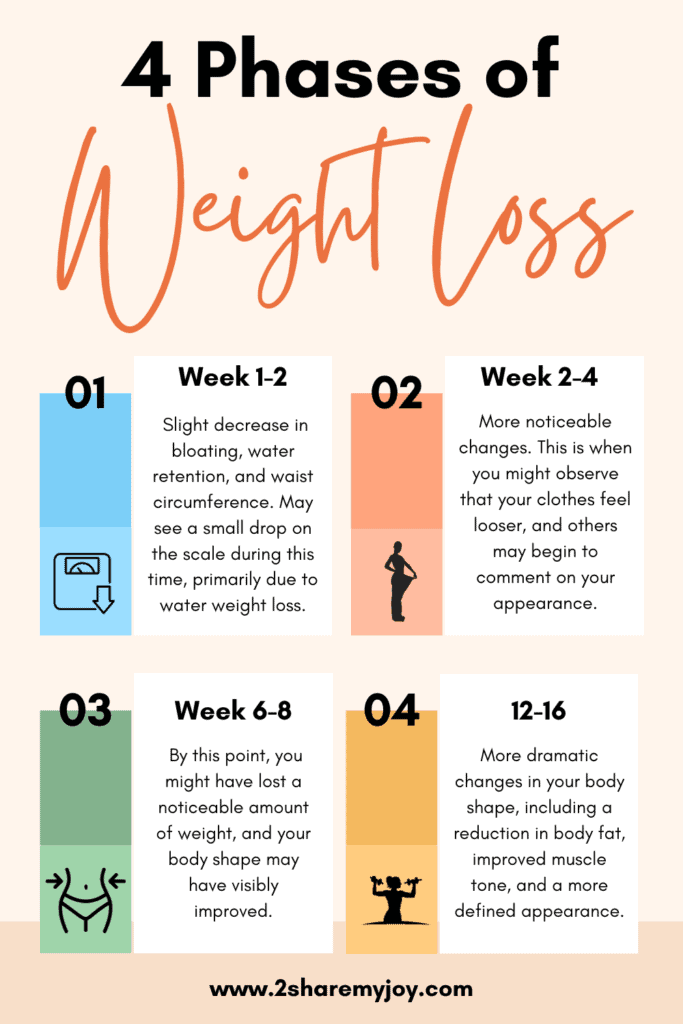The four stages of weight loss are initiation, action, maintenance, and stabilization. These phases are crucial for achieving and sustaining weight loss goals.
Embarking on a weight loss journey can seem daunting, but understanding the process helps in navigating it effectively. The initiation stage is all about making the decision to lose weight and setting realistic goals. During the action phase, individuals implement dietary changes and exercise routines to shed pounds.
Maintenance is the period where new habits are solidified to prevent weight regain. Finally, stabilization is the long-term adherence to a healthy lifestyle to maintain the achieved weight loss. A successful weight loss journey is not just about the numbers on the scale; it’s a holistic transformation that involves a balanced diet, consistent physical activity, and a resilient mindset. By breaking down the process into these manageable stages, individuals can focus on small, achievable steps that lead to significant health improvements over time.

Credit: www.myjuniper.com
Introduction To Weight Loss Stages
Welcome to the journey of weight loss! Understanding the stages can help you achieve your goals effectively. Each stage plays a crucial role in your transformation, and knowing what to expect can keep you motivated and on track.
Setting The Stage For Transformation
Weight loss is not just about shedding pounds; it’s a complete transformation of your lifestyle. The journey begins with preparing your mind and body. Here’s a simple breakdown:
- Goal setting: Clearly define what you want to achieve.
- Planning: Create a realistic, actionable plan.
- Commitment: Dedicate yourself fully to your goals.
Why Different Stages Matter
Each stage of weight loss has its unique challenges and rewards. Recognizing these can help you navigate through them with confidence. Here’s why understanding each stage matters:
- Preparation: Proper preparation prevents poor performance.
- Action: This is where you implement your plans.
- Maintenance: Focus on maintaining the achieved weight.
- Adaptation: Learn to adapt to new lifestyle changes.
Stage One: The Honeymoon Phase
Embarking on a weight loss journey can be thrilling. Stage One: The Honeymoon Phase is where the magic begins. It’s filled with motivation and a strong desire for change.
Initial Excitement And Rapid Results
In the first stage of weight loss, enthusiasm soars. New routines spark excitement. Meals are planned, workouts scheduled, and goals set. This phase often yields quick results as the body responds to new challenges.
- Enjoy the journey: Celebrate small victories to maintain momentum.
- Track progress: Use a journal or app to record achievements.
- Set realistic goals: Aim for attainable milestones to avoid burnout.
Common Challenges And How To Overcome Them
Despite initial success, challenges are common. Cravings may strike or schedules become hectic. The key is to stay focused and adapt.
| Challenge | Strategy |
|---|---|
| Cravings | Opt for healthy snacks and drink plenty of water. |
| Busy Schedule | Plan workouts ahead and sneak in activity when possible. |
| Plateau | Switch up your routine to challenge your body. |
Remember, the Honeymoon Phase is just the beginning. Stay committed, and you’ll build a foundation for lasting change.
Stage Two: The Plateau Period
The journey of shedding pounds often hits a snag at stage two, known as the Plateau Period. This stage can be both challenging and puzzling. The initial weight loss success seems to halt, and the scale refuses to budge. Understanding this phase is crucial for maintaining motivation and continuing progress towards weight loss goals.
Understanding The Weight Loss Plateau
After the early success of weight loss, the body adapts. It becomes more efficient, needing fewer calories to perform the same tasks. This natural adaptation can cause a stall in weight loss, known as a plateau. It’s a sign that the body is resisting change. But it’s also a normal part of the weight loss process.
Strategies To Break Through The Plateau
To overcome this stage, specific strategies can kickstart the body’s weight loss engine again.
- Revise your diet plan: Sometimes, a small tweak in calorie intake or food choices can make a big difference.
- Increase physical activity: Adding variety or intensity to workouts can push the body out of its comfort zone.
- Track your habits: Keeping a closer eye on diet and exercise can highlight areas for improvement.
- Manage stress: Stress can lead to weight retention, so finding ways to relax is key.
- Ensure adequate sleep: Sleep is essential for recovery and weight loss, aim for 7-9 hours per night.
Breaking through a weight loss plateau is challenging but possible. With the right strategies, patience, and persistence, progress will resume.
Stage Three: Steady Progress
As individuals journey through weight loss, they reach Stage Three. This stage is crucial. It’s a time of steady progress. Here, early excitement has turned into routine. Weight continues to drop. People feel more at ease with their new lifestyle. It’s not a rapid transformation anymore. It’s a consistent march towards the goal.
Consistency Is Key
Maintaining a daily routine is vital for steady weight loss. It’s about repeating good habits. Every healthy meal and workout counts. The body starts to adapt. Changes become more visible. Clothes fit better. Energy levels rise. The scale shows smaller numbers.
Adjusting Habits For Continued Success
Success in this stage often requires habit adjustments. It’s about fine-tuning the process. Eating and exercise may need changes. This keeps the body guessing and avoids plateaus.
- Track progress: Use a journal or an app.
- Seek variety: Try new foods and workouts.
- Set mini-goals: Celebrate small victories.
By staying flexible, individuals can overcome challenges. This ensures ongoing success in weight loss journeys.
Stage Four: The Maintenance Mode
Stage Four: The Maintenance Mode is the final phase in your weight loss journey.
It’s the ongoing process of staying on track after achieving your weight loss goal.
This stage is crucial.
It’s about keeping the weight off and living a healthier, balanced life.
Preserving Your Weight Loss Achievements
You’ve worked hard to reach your goal.
Preserving your weight loss is about continued vigilance and smart choices.
Keep up with your eating habits.
Stay active.
Remember, consistency is key.
Celebrate small victories to stay motivated.
Lifestyle Changes For Long-term Maintenance
Long-term maintenance requires permanent changes in your lifestyle.
Think of this as a new normal.
Eat well and exercise.
Manage stress effectively.
Get enough sleep.
These habits will help you maintain your new weight.
- Track your meals to avoid overeating.
- Plan workouts weekly.
- Find hobbies that keep you moving.
- Set realistic goals to stay focused.
- Connect with a support group.

Credit: medium.com
Psychological Aspects Of Weight Loss
The journey is much more than a physical challenge. It’s a mental game that demands resilience and adaptability. As individuals embark on this journey, understanding the psychological aspects becomes crucial for success. Weight loss is not just about shedding pounds; it’s about overcoming mental hurdles and transforming your mindset.
Emotional Rollercoaster Of Losing Weight
Weight loss can trigger a whirlwind of emotions. It’s common to feel motivated one day and defeated the next. As the body changes, so does the mind. People may experience joy at milestones reached but also frustration during plateaus or setbacks.
- Initial excitement often fuels the first days.
- Discouragement might creep in when results slow down.
- Determination is key to push through mid-journey challenges.
- Finally, pride and accomplishment await those who persevere.
Mental Strategies For Each Stage
Successful weight loss requires a toolbox of mental strategies. These strategies help navigate the ups and downs of the weight loss process.
| Stage | Mental Strategy |
|---|---|
| Start | Set clear, achievable goals to stay focused. |
| During Challenges | Use positive self-talk to overcome doubts. |
| On Plateaus | Remind yourself why you started for motivation. |
| Success Phase | Celebrate victories, no matter how small. |
Visualization techniques can also be powerful. Picture your success to create a sense of achievement. Keep a journal to track progress and reflect on growth. Most importantly, practice self-compassion. This journey is a marathon, not a sprint.
Nutritional Guidelines Through The Stages
Nutritional Guidelines Through the Stages of weight loss are essential for success. Correct food choices support a healthy metabolism. They also prepare the body for each weight loss phase. Follow these guidelines for a smoother journey.
Adapting Your Diet To Support Weight Loss
Balance is key in the diet adaptation stage. Your body needs a variety of nutrients to lose weight effectively.
- Eat more lean proteins to build muscle and burn fat.
- Choose complex carbs like whole grains for long-lasting energy.
- Fruits and vegetables are vital for vitamins and minerals.
- Reduce sugar and high-calorie foods to decrease calorie intake.
Track your meals to ensure you’re on the right path.
Supplements And Their Role In Your Journey
Supplements can fill nutritional gaps in your diet. Remember, they support but do not replace healthy eating habits.
| Supplement | Benefit | Recommended Stage |
|---|---|---|
| Protein powder | Muscle support | Active Weight Loss |
| Multivitamin | Overall health | All Stages |
| Fish Oil | Heart and joint health | Maintenance |
| Fiber | Digestive health | Calorie Deficit |
Consult a doctor before starting any supplement.
Exercise And Physical Activity
Exercise plays a crucial role. It burns calories, boosts metabolism, and improves overall health. Each stage demands a different exercise approach. Let’s explore how to tailor your workouts effectively.
Tailoring Your Exercise Regimen To Each Stage
- Initial Weight Loss: Start with moderate activities like walking or swimming.
- Continued Weight Loss: Increase intensity with activities such as jogging or cycling.
- Weight Loss Plateau: Mix in strength training to build muscle and burn fat.
- Maintenance: Find a balanced routine that includes both cardio and strength exercises.
Overcoming Physical Plateaus
Hitting a plateau can be challenging. Change your workout routine to overcome this stage. Here’s how:
- Increase Intensity: Push harder in your workouts. Use interval training.
- Vary Exercises: Try new activities to challenge your body in different ways.
- Rest and Recover: Give your body time to heal with proper rest days.
Monitoring Progress And Adjusting Goals
Embarking on a weight loss journey can feel like navigating uncharted waters. Monitoring progress and adjusting goals are key to reaching your destination. This stage is crucial. It helps you stay on track. You can celebrate victories. You can also make changes when needed.
The Importance Of Tracking Your Journey
Keeping a record of your weight loss journey is vital. It provides a clear picture of your progress. You can see what works. You can also identify what does not.
- Record daily meals to watch your eating habits.
- Track exercise routines to measure your activity levels.
- Note your emotions to understand how they affect your eating.
When To Revise Your Weight Loss Goals
Sometimes, the initial goals we set need tweaking. It’s part of the process. Recognize when it’s time to make changes.
| Signs to Revise Goals | Action to Take |
|---|---|
| Plateau in weight loss | Alter workout intensity or diet |
| Too easy or hard | Adjust the difficulty level |
| Changes in lifestyle | Update goals to fit new routines |
Listen to your body. It tells you what it needs. If you feel tired or hungry, your plan may need more calories or rest. Seek balance. It helps maintain motivation and ensure long-term success.
Success Stories And Inspiration
Exploring Success Stories and Inspiration can deeply motivate anyone on their weight loss journey. Real-life examples illustrate practical steps and real outcomes, making the goal seem attainable.
Real-life Transformations
Seeing is believing. Here are a few transformations that inspire:
- Jane Doe lost 50 pounds in 6 months. She changed her diet and started walking daily.
- John Smith shed 30 pounds by joining a local gym and focusing on strength training.
- Emma Brown managed to lose 20 pounds through yoga and mindful eating.
Learning From Others’ Experiences
Every story teaches us something valuable. Here’s what we can learn:
| Name | Strategy | Key Takeaway |
|---|---|---|
| Jane Doe | Diet + Walking | Consistency is key. |
| John Smith | Gym + Strength Training | Find a workout you enjoy. |
| Emma Brown | Yoga + Mindful Eating | Mind-body balance is crucial. |
Conclusion: The Journey Continues
The journey of weight loss does not end with reaching a target weight. It evolves into a new phase of maintaining and living a healthier lifestyle.
Embracing A New Lifestyle
Adopting a new lifestyle is crucial for lasting weight loss success. This means making consistent choices that support health and well-being. It’s about changing daily habits and making them a part of your life.
- Eat balanced meals
- Exercise regularly
- Get enough sleep
- Manage stress effectively
These changes should not feel like temporary fixes but rather integral parts of everyday life.
Staying Motivated Beyond The Scale
Motivation can wane after the initial weight loss phase. It’s essential to find new ways to stay motivated. Focus on non-scale victories, such as better sleep, more energy, and improved mood.
| Focus Area | Benefits |
|---|---|
| Better sleep | Improves overall health |
| More energy | Increases daily productivity |
| Improved mood | Enhances mental health |
Setting new goals can also help maintain motivation. Aim for goals related to fitness levels, strength, or endurance rather than just the scale.

Credit: www.2sharemyjoy.com
Frequently Asked Questions
What Is The Hardest Stage Of Weight Loss?
The hardest stage of weight loss is often the plateau phase, where progress seems to halt despite consistent effort.
Which Body Part Loses Fat First?
Fat loss often first occurs in the abdominal area. However, fat reduction patterns can vary based on individual genetics and lifestyle factors.
What Are The Stages Of Losing Belly Fat?
The stages of losing belly fat include calorie deficit creation, consistent physical activity, enhanced metabolism through muscle building, improved diet quality, and sustained healthy lifestyle habits.
What Are The Signs Of Losing Belly Fat?
Signs of losing belly fat include looser-fitting clothes, a more defined waistline, and a decrease in waist circumference. Visible abdominal muscles and improved body measurements are also indicators.
Conclusion
Embarking on a weight loss journey can be transformative. Recognizing the four stages—preparation, action, maintenance, and potentially relapse—is key. Each phase plays a crucial role in achieving long-term success. Stay committed, adapt as needed, and celebrate your progress. Your health and well-being are worth every step.




Leave a Reply